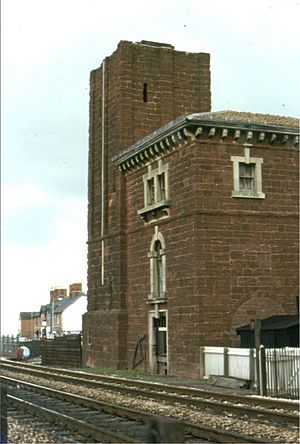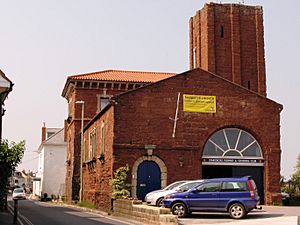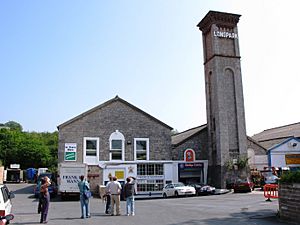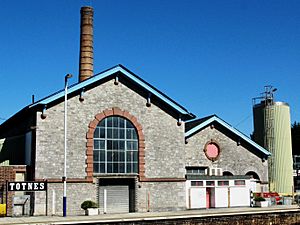South Devon Railway engine houses facts for kids
The South Devon Railway engine houses were special buildings in Devon, England. They were built to power unique "atmospheric trains" on the South Devon Railway. These trains ran between Exeter St Davids and Plymouth Millbay railway station. Inside the engine houses were big boilers. These boilers made steam that powered pumps. The pumps created a partial vacuum (like a strong suction) inside a long pipe laid along the railway track. This suction pulled the trains along! Today, three of these old engine houses are still standing.
Contents
How the Atmospheric Railway Worked
The idea for the South Devon Railway's atmospheric system came from a famous engineer named Isambard Kingdom Brunel. He wanted to try a new way to move trains. In 1843, Brunel and other engineers visited Dalkey in Ireland. They saw a similar system being tested there.
Brunel thought this system would save money. He believed it could reduce the need for a double-track line to a single track. This would save about £8,000 each year. The railway directors agreed to try Brunel's idea in 1844.
The special pipes for the railway were made by George Hennet. He set up a factory in Bridgwater, Somerset, just to make them.
When the Trains Started Running
The railway first opened with regular steam locomotives. This was on May 30, 1846, to Teignmouth. It then extended to Newton on December 30, 1846.
The first "piston carriage" arrived in February 1847. This carriage connected the train to the pipe. Soon after, experimental runs with the atmospheric power began. Public trains started using the system to Teignmouth in September 1847. By February 1848, all scheduled trains were powered by the atmospheric system.
Challenges and Problems
The atmospheric system faced many problems. The long pipe along the track had a special leather flap on top. This flap was supposed to seal the pipe and keep the vacuum strong. But the leather often dried out. When it dried, air could leak into the pipe. This made the vacuum weaker.
The railway line ran next to the sea for a long way. Salt spray from the ocean often soaked the leather flaps. Workers had to grease the leather with animal fat to keep it soft. But even with this, air still leaked in.
Another big problem was communication. The railway only had a simple telegraph system linking the stations. This meant engine houses had to start pumping for a train when it was scheduled to arrive. They would keep pumping until the train finally passed. Sometimes trains were very late. This meant the engines pumped for much longer than needed. They used a lot more coke (fuel) than they should have.
Why the System Stopped
Because of these problems, the railway company started an investigation in May 1848. In August, Brunel gave a long report about the system. The directors decided to stop using the atmospheric system.
So, the atmospheric trains ran for less than a year. The last atmospheric train ran on September 9, 1848. The engines and buildings were sold to other companies. Most of the special pipes were sold back to George Hennet for scrap metal. The atmospheric system had cost the railway over £433,000. They only got about £81,000 back from selling the old parts.
The system never expanded beyond Newton. Plans to use it on the Cornwall Railway were also dropped.
What Remains Today
Even though the system failed, some parts are still here! Three of the engine houses are still standing. These are at Starcross, Torquay, and Totnes. You can also clearly see where two others were located, at Turf and Dawlish.
A section of the special pipe is kept at the Didcot Railway Centre. It doesn't have its leather cover. It's mounted on a short piece of track to show how the railway looked.
How the Engines Worked
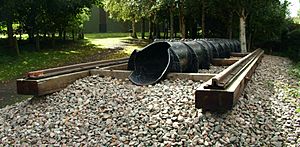
The atmospheric system was designed by the Samuda Brothers. They had a patent for their design. The main pipe was laid in 10-foot sections between the wide broad gauge rails. It had a continuous slot along the top, sealed by the leather valve.
The buildings that held the boilers and engines were built in a fancy Italianate style. They had square chimneys. These engine houses were placed about 3 miles apart along the track.
The engines that pumped the air were very powerful. The engine for each section would pump the air out of the pipe in front of the train. This created a partial vacuum. The normal air pressure behind the train's piston would then push the train forward. Pumping would start up to eight minutes before a train was scheduled to leave. This was to build up enough vacuum.
At stations, a smaller pipe was used. A piston in this pipe was connected to the train by a rope. This helped the train start moving. When a train arrived at the next station, the driver had to use the train's brakes to stop it.
Trains could reach speeds of up to 70 miles per hour (112 km/h)! But they usually traveled around 40 mph (64 km/h). The timetable allowed 55 minutes for a 20-mile journey. Records show that many trains arrived early, some by more than ten minutes!
Engine House Remains
Turf Engine House
You can see the remains of the Turf engine house. It's on the river side of the railway line. This is where the railway runs next to the River Exe, near Turf Lock. Turf Lock is the entrance to the Exeter Canal.
There's a square pond surrounded by trees near the river. This was the main water reservoir for the engine house. Just south of the pond, you can see the foundations of some buildings. This is where the engine house stood. The building was taken down around 1860. Its stones were used to build a nearby farm.
Starcross Engine House
The Starcross engine house is the most famous and complete one that was actually used. It's on the land side of the railway line, at the south end of Starcross railway station. The chimney was made shorter many years ago for safety.
This engine house is built from a red stone called Heavitree stone. This stone has not aged very well. The building was used by coal merchants after the railway stopped. From 1867 to 1958, the engine area was a church. Later, it was a youth club. In 1982, it became a museum about the atmospheric railway. That museum has since closed. Now, the building is used by the local Starcross Fishing and Cruising Club.
Dawlish Engine House
Most of the Dawlish engine house was taken down in 1873. But you can still see part of its wall. It's at the back of the car park at Dawlish railway station.
Torquay Engine House
By the time the railway opened to Torquay, the decision had already been made to stop using the atmospheric system. So, this engine house was never actually used. However, it was completed. It is the best-preserved example with the fewest changes to its outside.
It's a bit hard to see from trains. It's about 1 mile from Newton Abbot towards Torre. It's on a higher level above the railway line. You can get a better view of it from a supermarket car park on Newton Road.
Totnes Engine House
The engine house next to Totnes railway station was also never used for the railway. It was later changed into a milk processing plant for Dairy Crest. That plant has since closed. The original chimney was removed many years ago.


